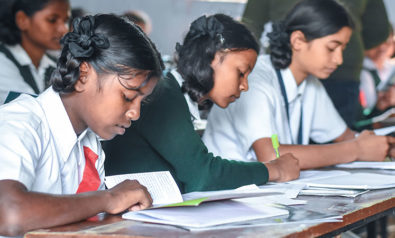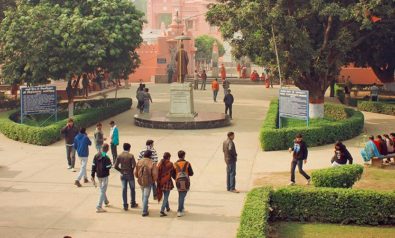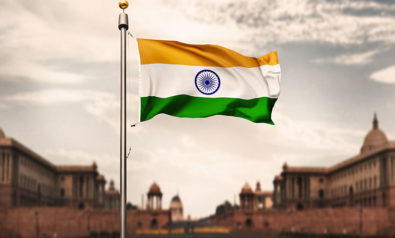The COVID-19 pandemic has detrimentally impacted education systems worldwide. Of the 1.2 billion children that the coronavirus has thrown out of classrooms, at least one-third have no access to remote learning and hence no access to education. The UN estimates that 24 million children will not return to school due to the fallout from the pandemic. Solving the education crisis needs to be a priority for governments.
India’s Health-Care System Is in Shambles
This issue is of particular significance in India, where the pandemic has steeply, and perhaps irreversibly, increased education inequality. Over 1.5 million schools have closed down, depriving 6 million children of basic education. The government has been preoccupied with issues such as the pandemic, the migrant crisis, the farmer protests and state elections. It has failed to focus on education.
Exacerbated Negatives
Even as capitalist a country as the United States provides its populace with free public schooling. In contrast, a supposedly socialist India is unable to educate its children. India, currently in its youth-bulge phase, has 600 million citizens under the age of 25. The education of these young people can and should be India’s catalyst for economic, social and political growth.
The socioeconomic benefits of education outweigh its costs. For example, the pervasiveness of child marriage among girls with no education is 30.8% versus 2.4% for girls who have received higher education. Bearing in mind the fact that more than one out of four Indian child brides become teenage mothers, providing girls with education could help solve the problem of child marriage, which would subsequently combat teenage pregnancy and high infant mortality rates. Education could also reduce the rampancy of child labor while also reducing rates of preventable diseases.
Unfortunately, the Right of Children to Free and Compulsory Education Act, 2009 (RTE) and India’s new education policy have no provision for dealing with the current crisis. Its Constitution declares India to be a “sovereign, socialist, secular, democratic republic.” Many politicians claim to be socialists. Yet the pandemic has proven that socialism is merely an empty slogan in India. Health and education are highly privatized. Citizens have to pay for basic treatments and for half-decent schools.
The education system had many issues long before COVID-19 made matters worse. The pandemic has only exacerbated the negatives. The RTE had noble intentions but mixed results. India needs a modern education system that expands both the minds of the young and the arc of their opportunities. The pandemic has been terrible for students, but it provides a great opportunity for reform. It remains to be seen if the government will grasp the opportunity.
Legislating Education
Under the current legislation, both the central government in Delhi and the state governments individually can pass laws concerning education. Generally, schools are administered by the state departments of education, while the central government dictates overall guidelines and policy. The Ministry of Human Resource Development oversees the education and literacy of the entire country, conducted in three types of schools: private unaided, private aided, and government-funded and government-run public schools. According to data from the Indian Education Ministry, 75% of all schools are government-owned, responsible for the education of approximately 65% of all school students, or 113 million, across 20 states.
According to Oxfam India, 80% of students in government schools have received no education since the pandemic began. Furthermore, despite the government broadcasting certain classes on television, many students have been unable to access them because they lack basic infrastructure at home. Over 200 million Indians do not own a television, phone or radio. Additionally, this method of teaching and learning is not interactive, with students finding it difficult to grasp the material.
While poor government schools remain closed, private schools have adapted to virtual learning. However, only 23% of all Indian households have access to a computer. This figure drops to only 4% among the rural population. Rural areas in particular are struggling with the fallout from the pandemic such as the migrant crisis and rampant unemployment, so education ranks low on local governments’ priority lists.
To make matters worse, the closing of schools in early 2020 translated to the effective cancellation of the Mid-Day Meal Scheme that provided 116 million schoolchildren with hot meals. The central government has drafted guidelines for states and union territories to supply cooked meals or food-security allowances to schoolchildren. However, it is clear that various municipalities have failed to implement these guidelines. For instance, Bihar took 44.6 million tons of grains from the central government in 2019 to feed schoolchildren; in 2020, this figure dropped to zero. Children are not only missing out on education but also on nutrients. This is reversing years of progress that India had made in combating malnutrition. It is well known that malnutrition hinders intellectual development and can lead to poor academic performance, disease and even death. Children in poor families now face an increased risk of malnutrition as the gap between them and their more prosperous counterparts increases by the day.
But even children from more affluent families are struggling to cope with online learning. Depression and anxiety are on the rise. In India, board examinations — the final set of tests for students graduating from high school — have been canceled. This has left millions of students worrying about their future.
Misguided Provisions
One of the key problems with the Right of Children to Free and Compulsory Education Act is that it is poorly drafted. It is unclear and repetitive. According to the District Information System of Education, as of 2016, only 13% of all Indian schools achieved compliance with RTE norms. As a national act, the RTE establishes certain parameters, procedures and standards for both private and public schools to follow. It places a primary emphasis on the idea of education for all by dictating that every child between the ages of six and 14 must be eligible to receive free education. However, Indian children are still struggling to obtain the education promised to them.
The most adversely affected are the children living in rural areas who make up 73% of Indian youth. About 90% of the facilities in these districts are government-run public schools that struggle with untrained teachers and poor infrastructure, failing to meet the standards set by the RTE. Schools that do not follow these standards are forced to shut down. In many cases, these schools are the only option available.
According to the India School Closure Report published by Centre for Civil Society in India, between April 2015 to March 2018, 2,469 schools were closed in 14 states due to RTE non-compliance, while 4,482 were threatened with closure and a further 13,546 were served closure notices. In line with Luis Miranda’s analysis for Forbes India, if we assume an average of 200 students per institution in Punjab, the closure of 1,170 schools there as of August 2015 amounted to 234,000 students being unable to attend a school of their choice or to receive an education at all in just one state.
For several states, data on the extent of school closures remain missing. As of 2016, total enrolment in public schools was only 1% higher for elementary schools and 2% higher for secondary schools compared to 2000. Data from 2016 reveal that enrolment decreased in states such as Madhya Pradesh, Assam and West Bengal.
The RTE has misguided provisions that may be well-meaning but are highly damaging. The act mandates a 25% quota to be reserved at the entry-level of educational institutions for students from economically weaker sections and disadvantaged groups. The law states that the central government must reimburse schools for the costs incurred due to the quota by either paying schools’ per-child expenses or the fees charged, whichever is lower.
However, this provision has been implemented unevenly. In 2013-14, Madhya Pradesh filled 88.2% of the 25% quota and Rajasthan filled 69.3%, while states like Uttar Pradesh managed only 3.62% and Andhra Pradesh just 0.21%. Furthermore, corruption under the quota provision is also rampant. Parents often issue fraudulent income certificates to qualify under the quota, and schools do not oppose bribery as they favor students from affluent families. When wealthy private schools try to integrate economically weaker students, existing students often withdraw their admission due to a broad physical, infrastructural and cultural chasm between the classes. In India, there is still a stigma around studying with someone from a vastly differing economic background.
Adding Insult to Injury
There is another problem with the quota system for economically underprivileged children. The central government is supposed to reimburse state governments who fund schools for filling their quota. Unfortunately, there is no methodology for this. The central government decides on an ad hoc basis what any state is supposed to get. For example, in India’s most populous state of Uttar Pradesh, expenditure per child per year is 3,064 rupees, or approximately $41. However, the central government gives this state of 236 million people only 450 rupees, or around $6, for every poor child. Naturally, schools have little incentive to fill their quota for economically underprivileged children, meaning that a mere 3.62% of the seats are filled.
More significantly, the RTE has failed to address the fundamental issue of the lack of quality in Indian education. According to the 2018 “Annual Status of Education Report,” 55% of fifth graders in public schools could not read a second-grade textbook. The quality of teachers tends to be poor. Their pedagogies are almost invariably outdated. Teachers often lack motivation and training. In 2015-16, 512,000 teachers — or one in six — in elementary government schools were untrained.
One nationwide survey revealed a teacher absentee rate of 23.6% in rural areas. In states like Uttar Pradesh, teachers are hired by paying bribes. Often, they are barely literate. When teachers are qualified, they often run private coaching businesses instead of teaching in the schools.
To add insult to injury, untrained teachers use curricula that have little relevance to the lives of poor schoolchildren. They champion rote-based learning and, more often than not, destroy creativity. Many schools lack proper buildings, decent roofs and proper toilet facilities, especially for girls. Blackboards, basic learning aids and even chalk can run short. In 2018-19, only 28% of all government schools had computers and only 12% had an internet connection. Despite the government campaigning for a digital India, it has done little to provide computers and internet connectivity to schools across the country.
Time for Reform
As of 2020, India spent just 3.1% of its GDP on education. Importantly, every national policy since 1968 has recommended a figure of 6%. Other developing countries such as South Africa and Brazil spend 6.5% and 6.3% respectively. The government of India could start with emulating its BRICS counterparts in increasing the amount it spends on rearing the next generation.
Even the little amount India spends on education often does not reach schoolchildren, the intended beneficiaries of the system. Like all aspects of Indian life, corruption causes much harm to the most vulnerable of the country’s citizens. The upper and middle classes almost invariably send their children to private schools, as do officials in charge of drafting India’s education policy. It is only the children of the poor who end up in government education, with parents having little knowledge or influence to demand either accountability or quality.
Officers of the Indian Administrative Service (IAS) preside over all ministries in India from finance and industry to culture and education. These IAS officers have little if any experience in education. These officers often spend their time trying to get postings to departments with more power and greater opportunities for corruption. They have little incentive to reform the broken system either at the level of the state or national government. Politicians see little gain from focusing on education either. They are always too busy with the next election.
India’s citizens have to demand better use of their taxpayer money. The best use of that money in the long term is investment in education, not only in as funding but also good policymaking. Politicians must entrust this policy to educationists, not IAS officers. In the past, India’s great institutions were set up by the likes of Rabindranath Tagore, Madan Mohan Malaviya and Sir Syed Ahmad Khan, not faceless bureaucrats.
India needs educational reform now more than ever. The pandemic has been devastating for hundreds of millions of students. If the government fails to act now, India will become an even more unequal and divided nation than it is today. Without high-quality mass education, the country will never have the skill or the knowledge base to be a truly dynamic economy. India’s government schools need to be good enough for the children of top politicians, not just for its poor downtrodden masses.
The views expressed in this article are the author’s own and do not necessarily reflect Fair Observer’s editorial policy.
Support Fair Observer
We rely on your support for our independence, diversity and quality.
For more than 10 years, Fair Observer has been free, fair and independent. No billionaire owns us, no advertisers control us. We are a reader-supported nonprofit. Unlike many other publications, we keep our content free for readers regardless of where they live or whether they can afford to pay. We have no paywalls and no ads.
In the post-truth era of fake news, echo chambers and filter bubbles, we publish a plurality of perspectives from around the world. Anyone can publish with us, but everyone goes through a rigorous editorial process. So, you get fact-checked, well-reasoned content instead of noise.
We publish 2,500+ voices from 90+ countries. We also conduct education and training programs
on subjects ranging from digital media and journalism to writing and critical thinking. This
doesn’t come cheap. Servers, editors, trainers and web developers cost
money.
Please consider supporting us on a regular basis as a recurring donor or a
sustaining member.
Will you support FO’s journalism?
We rely on your support for our independence, diversity and quality.




















